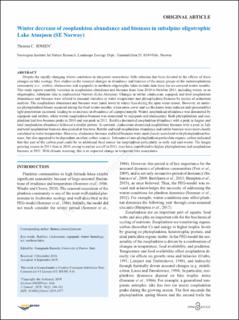| dc.description.abstract | Despite the rapidly changing winter conditions in temperate ecosystems, little attention has been devoted to the effects of these changes on lake ecology. Few studies on the seasonal changes in abundance and biomass of the major groups of the metazooplankton community (i.e,. rotifers, cladocerans and copepods) in northern oligotrophic lakes include data from the ice-covered winter months. This study reports monthly variation in zooplankton abundance and biomass from June 2010 to October 2011, including winter, in an oligotrophic, subalpine lake in southeastern Norway (Lake Atnsjøen). Changes in rotifer, cladoceran, copepod, and total zooplankton abundances and biomass were related to seasonal variation in water temperature and phytoplankton biomass by means of ordination analysis. The zooplankton abundance and biomass were much lower in winter than during the open water season. However, an underice phytoplankton bloom occurred during the final winter months, when snow cover and ice thickness were reduced and (presumably) light penetration increased, leading to an increase in abundance of copepod nauplii. Winter zooplankton abundance was dominated by copepods and rotifers, while winter zooplankton biomass was dominated by copepods and cladocerans. Both phytoplankton and zooplankton had two biomass peaks in 2010 and one peak in 2011. Rotifers dominated zooplankton abundance with a peak in August and total zooplankton abundance followed a similar pattern. In contrast, cladocerans dominated zooplankton biomass with a peak in July and total zooplankton biomass also peaked at this time. Rotifer and total zooplankton abundance and rotifer biomass were most closely correlated to water temperature. However, cladoceran biomass and total biomass were most closely correlated with phytoplankton biomass, but also appeared to be dependent on other carbon sources. Estimates of non-phytoplankton particulate organic carbon indicated that this part of the carbon pool could be an additional food source for zooplankton particularly in early and mid-winter. The longer growing season in 2011 than in 2010, owing to earlier ice-off in 2011, may have contributed to higher phytoplankton and zooplankton biomass in 2011. With climate warming, this is an expected change in temperate lake ecosystems. | en_US |

